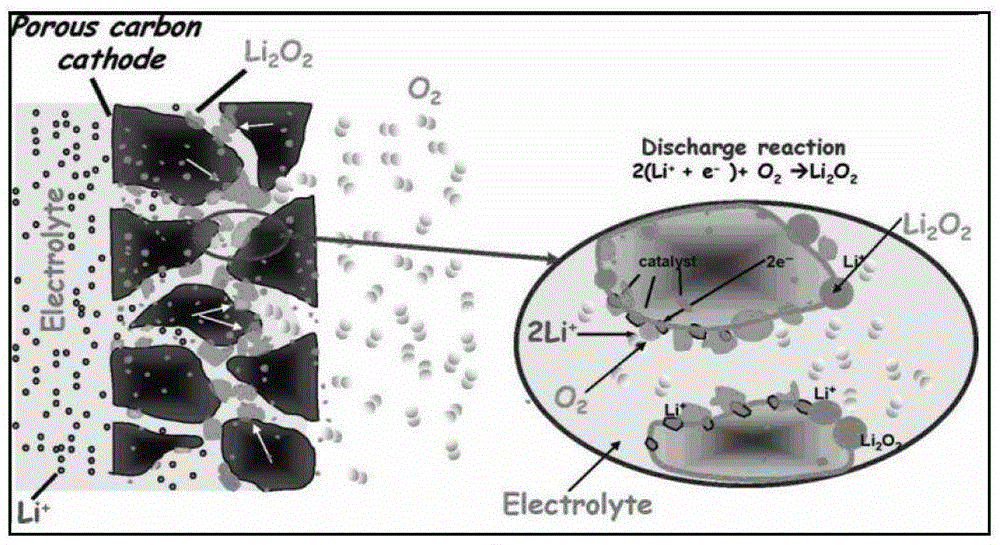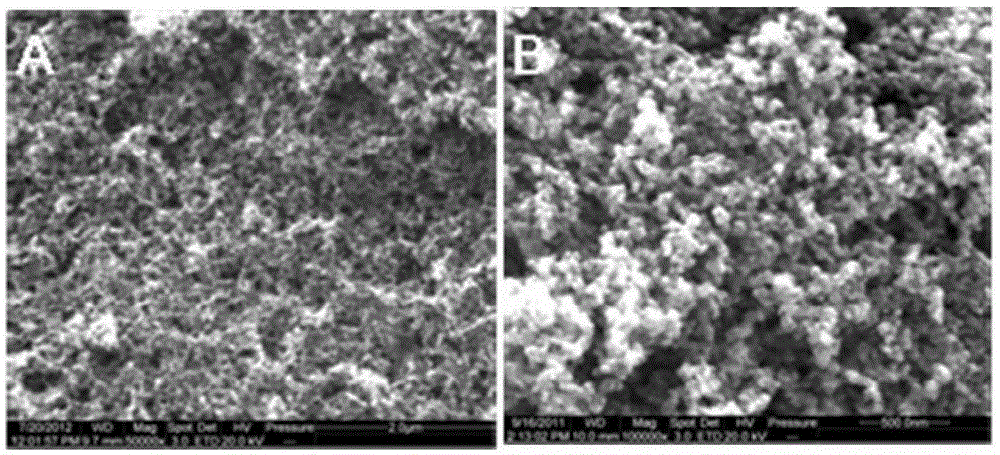Lithium-air battery cathode uses porous carbon material
A technology of porous carbon materials and air batteries, which is applied to battery electrodes, fuel cell half-cells, secondary battery-type half-cells, circuits, etc., can solve the problem of not being able to fully utilize the space of the pores and the central part of the large pores. To improve the space utilization rate, increase the energy density and power density, and shorten the diffusion distance
- Summary
- Abstract
- Description
- Claims
- Application Information
AI Technical Summary
Problems solved by technology
Method used
Image
Examples
Embodiment 1
[0034]Porous carbon materials with hierarchical pore structure were prepared by sol-gel method combined with activation method. Dissolve 6.16g of resorcinol in 10mL of deionized water to form a transparent solution; add 9.08g of formaldehyde solution and 0.808g of ferric nitrate to the stirring solution, stir and mix evenly, and continue to stir in an environment of 20°C until The reaction forms a gel; transfer the gel to a vacuum drying oven for 3 days of vacuum drying and aging treatment at 70°C, take it out and grind it to obtain a solid powder; put the solid powder in N 2 Treat at 850°C for 2 hours, wash off the iron oxide with an appropriate amount of 2M hydrochloric acid, and filter and dry to obtain the carbon material.
[0035] The positive electrode material structure prepared in Example 1 has a large number of deposition pores with a diameter of 10 to 40 nanometers, and graded pores with mass transfer pores of 0.1 to 0.5 microns. The distance between the mass transfe...
Embodiment 2
[0040] Porous carbon materials with hierarchical pore structure were prepared by sol-gel method combined with activation method. Dissolve 6.16g of resorcinol in 10mL of deionized water to form a transparent solution; add 9.08g of formaldehyde solution to the above stirring solution, stir and mix evenly, and continue stirring at 20°C until the reaction forms a gel; Transfer the gel to a vacuum drying oven for 3 days of vacuum drying and aging treatment at 70°C, take it out and grind it to obtain a solid powder; put the solid powder in N 2 After being treated at 850°C for 2 hours, it was purged to room temperature, and then the carbon material was activated by water vapor. The activation temperature was 800°C, the activation time was controlled at 30 minutes, and the water vapor intake flow rate was controlled at 20ml / min; that is, the hierarchical pore structure is porous. carbon material.
Embodiment 3
[0042] Porous carbon materials with hierarchical pore structure were prepared by sol-gel method combined with activation method. Dissolve 6.16g of resorcinol in 10mL of deionized water to form a transparent solution; add dropwise 9.08g of formaldehyde solution to the stirring solution, stir and mix evenly, and continue stirring at 20°C until the reaction forms a gel ; transfer the gel to a vacuum drying oven for 4 days of vacuum drying and aging treatment at 70 ° C, take it out and grind it to obtain a solid powder; put the solid powder in N 2 Treat at 800℃ for 2h, change CO 2 Purge at 800°C for 1h, then change to N 2 Purge to room temperature, that is, a porous carbon material with hierarchical pore structure.
PUM
| Property | Measurement | Unit |
|---|---|---|
| pore size | aaaaa | aaaaa |
Abstract
Description
Claims
Application Information
 Login to View More
Login to View More - R&D
- Intellectual Property
- Life Sciences
- Materials
- Tech Scout
- Unparalleled Data Quality
- Higher Quality Content
- 60% Fewer Hallucinations
Browse by: Latest US Patents, China's latest patents, Technical Efficacy Thesaurus, Application Domain, Technology Topic, Popular Technical Reports.
© 2025 PatSnap. All rights reserved.Legal|Privacy policy|Modern Slavery Act Transparency Statement|Sitemap|About US| Contact US: help@patsnap.com


